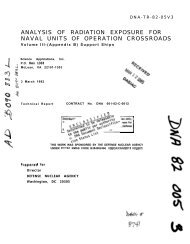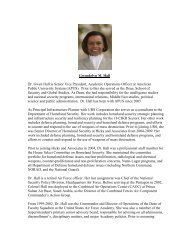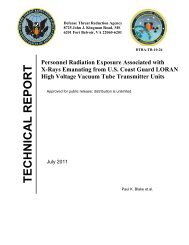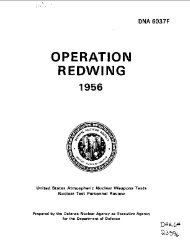Shield - Defense Threat Reduction Agency
Shield - Defense Threat Reduction Agency
Shield - Defense Threat Reduction Agency
You also want an ePaper? Increase the reach of your titles
YUMPU automatically turns print PDFs into web optimized ePapers that Google loves.
Expert Oversight: the Veterans’ Advisory<br />
Board on Dose Reconstruction<br />
Because of the complexity of a dose reconstruction – and<br />
its importance in determining compensation and benefi ts for<br />
atomic vets – there is a lot of concern about the accuracy and<br />
validity of the dose reconstruction process. After hearing from<br />
concerned veterans, Congress ordered the General Accounting<br />
offi ce to conduct and independent review of the dose reconstruction<br />
process. the GAo concluded that the process was<br />
valid but it also noted that there was room for improvement,<br />
including the need for an independent review. the national<br />
research Council was then asked to review dose reconstruction<br />
and determine the accuracy of the whole process. In December<br />
of 2003, Congress passed and president Bush signed<br />
the Veterans’ Benefi ts Act of 2003, which established a board<br />
charged with oversight of dose reconstruction and sharing information<br />
with atomic vets – the Veterans’ Advisory Board on<br />
Dose reconstruction.<br />
having a board responsible for oversight and auditing the process<br />
is a good idea, but the VBDr needed to have the right<br />
people in order to conduct complex audits and make meaningful<br />
recommendations. the law specifi ed that the board, at a<br />
minimum, must include:<br />
n a historical dose reconstruction expert<br />
n a radiation health expert<br />
n a risk communications expert<br />
n representatives from DtrA and the VA<br />
n three veterans (at least one must be a member of an<br />
atomic veterans group)<br />
the current board includes eight veterans, eight doctors, three<br />
certifi ed health physicists, two scientists, and the chairman<br />
of the board is a former surgeon General of the United states<br />
Air force: retired lieutenant General Charles roadman II, m.D.<br />
the VBDr has conducted dozens of dose reconstruction audits<br />
and made dozens of recommendations to the VA and DtrA’s<br />
ntpr program that have resulted in faster claims process, a<br />
reduced backlog and improved communications with atomic<br />
vets. the VBDr continues to look at ways to improve the dose<br />
reconstruction process, how that information is shared with<br />
atomic vets, how to minimize the time and cost of the whole<br />
process, and ways to make complex, scientifi c dose reconstruction<br />
assessments easier to understand for atomic vets.<br />
the VBDr held its eleventh meeting earlier this year; fi ve presentations<br />
were given and the board made four recommendations<br />
for improvement to the VA; there were no recommendations<br />
made to DtrA at this time. n<br />
2 / the shield / fall 2011<br />
(above) Crew members decontaminate a B-17G flying fortress after a nuclear weapon test.<br />
Vehicles, planes, and even some of the target ships used in multiple tests had to be scrubbed<br />
down or hosed off after each test, although underwater and high altitude bursts usually had<br />
less or little ionizing radiation compared to tests on land. (left, top) Operation HARDTACK I,<br />
June 8, 1958. the ship in the foreground is the ss Michael Moran, a mothballed liberty ship<br />
used as a target in two underwater nuclear weapons tests, shot WAhoo and shot UmBrellA<br />
(pictured here), conducted near the enewetak Atoll in the pacifi c proving Grounds. (left,<br />
bottom) Operation BUSTER-JANGLE, Nov. 4, 1951. exercises Desert rock I, II and III were<br />
conducted during this test series (shot DoG pictured here); thousands of troops from all four<br />
branches of the military participated in observer programs, tactical maneuvers and damage<br />
effects tests.<br />
n How much protection various structures off ered and where the<br />
veteran was (topside on an observation ship, or down in the<br />
boiler room?)<br />
In addition to all those variables, there are still some uncertainties that<br />
still exist today, like post-detonation measurements that were marked<br />
on a paper map by hand – something that would be accomplished by<br />
computers and GPS readings today with extreme accuracy.<br />
Some cases may have large information gaps that need to be fi lled<br />
in, but dose reconstructions are not simply hypothetical ‘guesstimations.’<br />
As with any scientifi c research, a known benchmark is required.<br />
Six diff erent military units involved in land and sea-based<br />
tests during the 1950s for which detailed records exist were used as<br />
case studies. Th e NTPR program completed dose reconstructions to<br />
see if the methods and tools used came up with answers consistent<br />
with the data that already existed. Th e methods and tools used were<br />
proven to work, but with any scenario, there is a wide spectrum of<br />
results, from veterans who were exposed to barely any radiation to<br />
those exposed to a signifi cant amount. Th e NTPR solution to ensure<br />
atomic vets get benefi t of the doubt? Assume a worst case scenario.<br />
It’s actually a lot more scientifi c and complex than that, but in giving<br />
benefi t of the doubt to atomic vets, the NTPR program tries to see if<br />
the results are greater than what 95 percent of the exposed population<br />
would have received. Th is practice probably means some veterans<br />
that received little or no radiation are treated as if they did, but<br />
more importantly it also prevents the Department of <strong>Defense</strong> from<br />
treating veterans that probably did get a not insignifi cant amount<br />
of radiation as if they didn’t. In solving the radiation riddle for our<br />
atomic veterans, though, it makes perfect sense – try to get the right<br />
answer, but make sure you do the right thing. n









